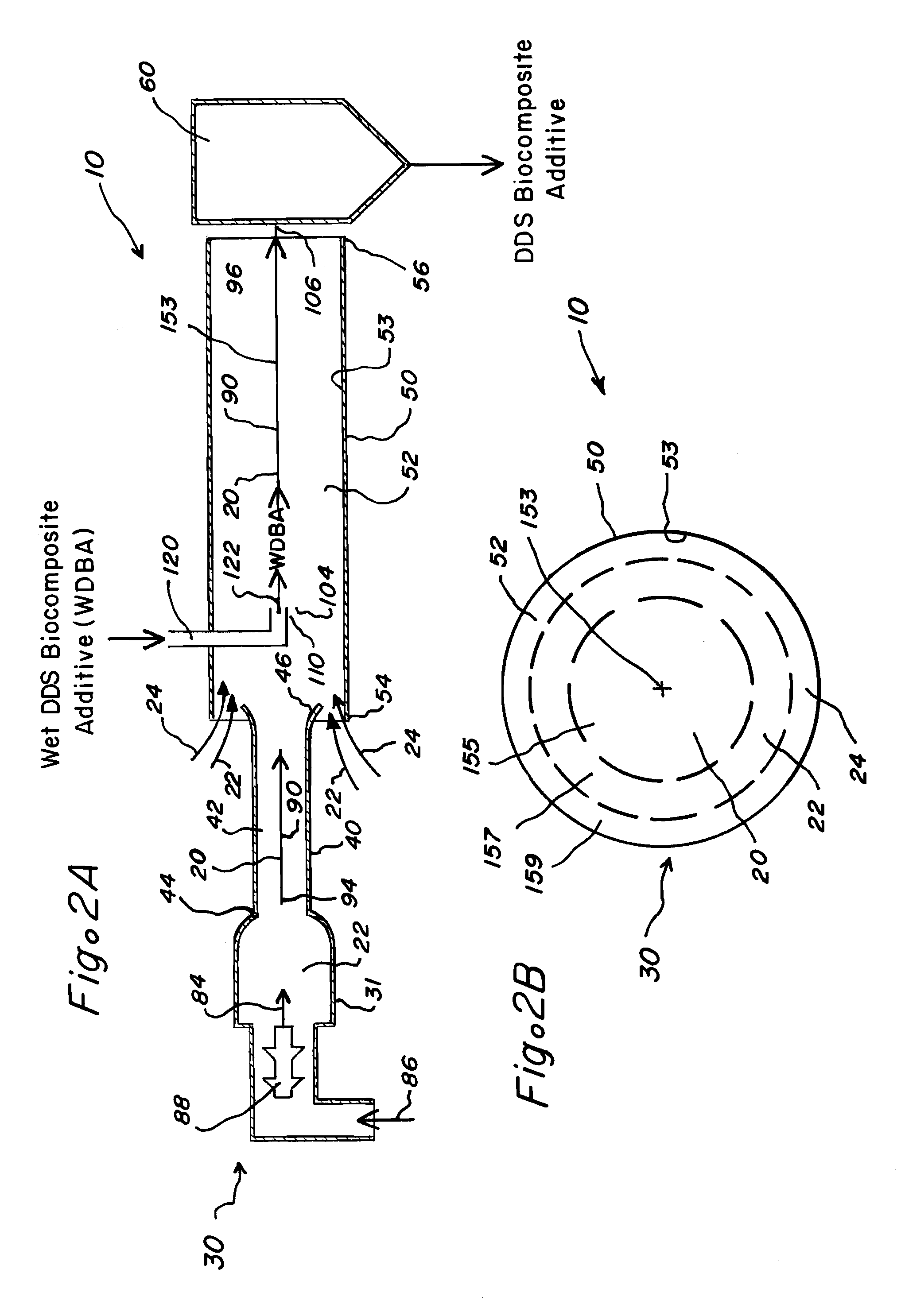Multifunctional biocomposite additive compositions and methods
a technology of additive compositions and biocomposites, applied in textiles and papermaking, synthetic resin layered products, drying machines, etc., can solve the problems of general incompatibility of recycled mixed plastics from domestic and commercial waste, and general toxic and expensive other chemical compatibility agents
- Summary
- Abstract
- Description
- Claims
- Application Information
AI Technical Summary
Problems solved by technology
Method used
Image
Examples
example 1
Production of DDS Biocomposite Thermoplastic by Pulse Combustion Drying Condensed Distiller's Solubles with Additives
[0129]Condensed distiller's solubles (CDS) was obtained from an operating corn ethanol facility. The measured solids concentration in the material was 32% and it had the appearance of a thick viscous liquid. The liquid was combined with cellulose fibers obtained from a paper recycling stream, industrial grade titanium dioxide, and white latex paint. After drying, the mixing formula of ingredients was 61% dry weight DDS, 25% cellulose fiber, 7% titanium dioxide, and 7% white latex paint solids.
[0130]This liquid mixture was introduced into a P-1 Pulse Combustion Drier (Pulse Combustion Systems, Payson, Ariz.) using an impeller pump. The drier was operated at 800,000 Btu per hour heat release and an exit temperature of 180° F. The liquid mixture dried into a light tan powder with residual moisture content of less than 5%. This powder is one formulation of DDS biocomposit...
example 2
DDS Biocomposite Additive Used as a Compatiblizing Additive with Post Consumer Comingled Recycled Plastic
[0131]A supply of post consumer comingled recycled plastic (PCCRP) was obtained from a plastics recycling line. The materials were estimated to contain approximately 50% styrene mixed with olefins, PVC and other unknown plastics that occur in the stream. The recommended processing temperature for extrusion of this thermoplastic mix was 450° F.
[0132]A single screw thermoplastic extruder with a 2 inch barrel was used to conduct trial extrusions through a rectangular die into a water cooling bath and out of the bath through a puller used to keep the extruded material taut. The extruder was preheated to 450° F. and PCCRC with no addition was loaded into the feed hopper. The material emerged from the die in strings with obvious unmixed sections and discontinuities. PCCRC with a 5% addition of the DDS Biocomposite Additive, as described in Example 1, was fed into the extruder. The mate...
example 3
Reduction in Processing Temperatures by Addition of a DDS Biocomposite Additive to Thermoplastic Resins
[0133]In Example 2 the recommended processing temperature of the PCCRC was 450° F. The PCCRC was mixed with 5% by weight DDS biocomposite additive as described in Example 1, and loaded into the feed hopper of the extruder. As the material was being extruded the temperature was ramped down in 50° F. increments and allowed to stabilize at each step. The extrusion energy was monitored by the amp draw of the drive motor and the quality of the extrusion was monitored by inspection.
[0134]The temperature was reduced to 400° F., 350° F. and 300° F. For the first two increments there was no measured increase in amp draw. The extrusion rate and quality of the extrusion product did not change. At 300° F. the amp draw increased approximately 15%. The extrusion product began to show inclusions of material that had not melted and combined homogeneously with the other materials.
[0135]The addition...
PUM
| Property | Measurement | Unit |
|---|---|---|
| temperatures | aaaaa | aaaaa |
| diameter | aaaaa | aaaaa |
| frequency | aaaaa | aaaaa |
Abstract
Description
Claims
Application Information
 Login to View More
Login to View More - R&D
- Intellectual Property
- Life Sciences
- Materials
- Tech Scout
- Unparalleled Data Quality
- Higher Quality Content
- 60% Fewer Hallucinations
Browse by: Latest US Patents, China's latest patents, Technical Efficacy Thesaurus, Application Domain, Technology Topic, Popular Technical Reports.
© 2025 PatSnap. All rights reserved.Legal|Privacy policy|Modern Slavery Act Transparency Statement|Sitemap|About US| Contact US: help@patsnap.com


